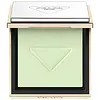What's inside
What's inside
 Key Ingredients
Key Ingredients

 Benefits
Benefits

 Concerns
Concerns

 Ingredients Side-by-side
Ingredients Side-by-side

Perlite
AbsorbentMica
Cosmetic ColorantSqualane
EmollientSynthetic Fluorphlogopite
C12-15 Alkyl Benzoate
AntimicrobialLauroyl Lysine
Skin ConditioningHydrogenated Polyisobutene
EmollientBoron Nitride
AbsorbentCalcium Aluminum Borosilicate
Magnesium Stearate
Cosmetic ColorantParfum
MaskingSilica
AbrasiveHydrogenated Styrene/Butadiene Copolymer
Caprylyl Glycol
EmollientLimonene
PerfumingCI 19140
Cosmetic ColorantIsododecane
EmollientSorbitan Isostearate
EmulsifyingCI 42090
Cosmetic ColorantAlpha-Isomethyl Ionone
PerfumingGeraniol
PerfumingCitronellol
PerfumingBenzyl Salicylate
PerfumingLinalool
PerfumingBenzyl Alcohol
PerfumingTris-BHT Mesitylene
AntioxidantTocopherol
AntioxidantPerlite, Mica, Squalane, Synthetic Fluorphlogopite, C12-15 Alkyl Benzoate, Lauroyl Lysine, Hydrogenated Polyisobutene, Boron Nitride, Calcium Aluminum Borosilicate, Magnesium Stearate, Parfum, Silica, Hydrogenated Styrene/Butadiene Copolymer, Caprylyl Glycol, Limonene, CI 19140, Isododecane, Sorbitan Isostearate, CI 42090, Alpha-Isomethyl Ionone, Geraniol, Citronellol, Benzyl Salicylate, Linalool, Benzyl Alcohol, Tris-BHT Mesitylene, Tocopherol
Ingredients Explained
These ingredients are found in both products.
Ingredients higher up in an ingredient list are typically present in a larger amount.
Mica is a naturally occurring mineral used to add shimmer and color in cosmetics. It can also help improve the texture of a product or give it an opaque, white/silver color.
Serecite is the name for very fine but ragged grains of mica.
This ingredient is often coated with metal oxides like titanium dioxide. Trace amounts of heavy metals may be found in mica, but these metals are not harmful in our personal products.
Mica has been used since prehistoric times throughout the world. Ancient Egyptian, Indian, Greek, Roman, Aztec, and Chinese civilizations have used mica.
Learn more about MicaSilica, also known as silicon dioxide, is a naturally occurring mineral. It is used as a fine, spherical, and porous powder in cosmetics.
Though it has exfoliant properties, the function of silica varies depending on the product.
The unique structure of silica enhances the spreadability and adds smoothness, making it a great texture enhancer.
It is also used as an active carrier, emulsifier, and mattifier due to its ability to absorb excess oil.
In some products, tiny microneedles called spicules are made from silica or hydrolyzed sponge. When you rub them in, they lightly polish away dead skin layers and enhance the penetration of active ingredients.
Learn more about SilicaSynthetic Fluorphlogopite is the synthethic version of mica. It consists of fluorine, aluminum and silicate.
Synthetic Fluorphlogopite is used to add volume to products.
It is considered non-irritating on the skin.
Learn more about Synthetic Fluorphlogopite